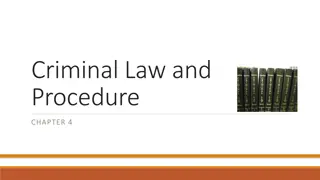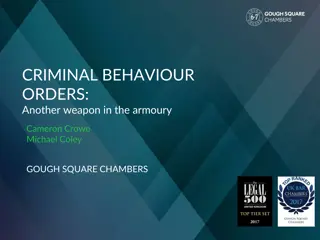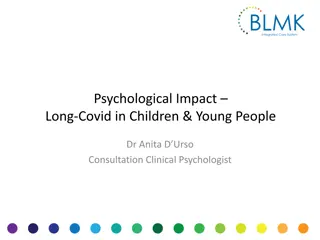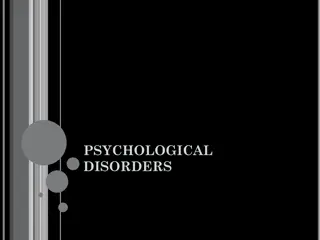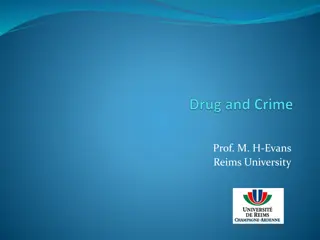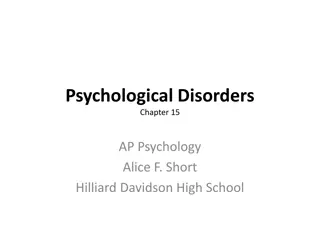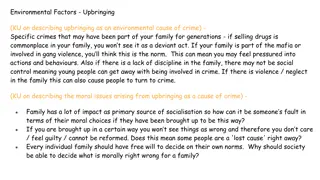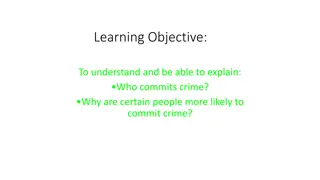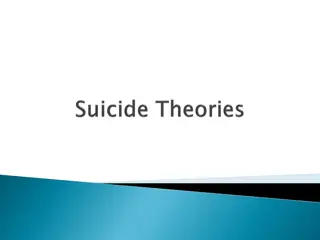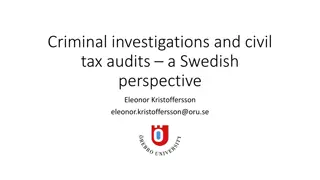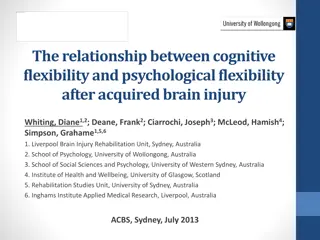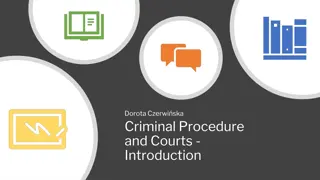Understanding Criminal Behavior from a Social Psychological Perspective
This unit delves into the application of social psychology in the legal system, exploring the nature of criminal behavior, responses to criminal acts, the criminal justice system, and rehabilitation. It examines the social ecological perspective of criminal acts and outlines key points related to the crime, the criminal, and bystander intervention in criminal situations.
Download Presentation

Please find below an Image/Link to download the presentation.
The content on the website is provided AS IS for your information and personal use only. It may not be sold, licensed, or shared on other websites without obtaining consent from the author. Download presentation by click this link. If you encounter any issues during the download, it is possible that the publisher has removed the file from their server.
E N D
Presentation Transcript
LEGAL SYSTEM AND APPLIED SOCIAL PSYCHOLOGY UNIT - 3
INTRODUCTION This criminal acts, vicious attack raises many questions about the nature of criminal behavior and about people s responses to criminal acts that may be examined from a social psychological perspective. Moreover, beyond the particular criminal incident, social psychological theory and research can be applied to understand and address other aspects of the criminal justice system, including the police investigation, the criminal trial, and the rehabilitation of criminal incarceration and offenders.
SOCIAL ECOLOGICAL PERSPECTIVE OF CRIMINAL ACTS Criminal ecological perspective, that interaction between This notionderives B = f(P, E), which states that the environment (E), and the interaction Withregardto criminal compelled to offendonly environmental stimulus acts may be viewed is, person from a the and social as result of an the famous theorem, the from Kurt environment. Lewin s behavior (B) is a function of the person (P), between behavior, an individual in the presence that acts as a sort of the may be of trigger. two. an
CHAPTER OUTLINE(POINTS) APPLICATION OF SOCIAL PSYCHOLOGY IN LEGAL SYSTEM .. 1. The Crime andthe Criminal - The Social Psychology of a Crime - The Origins of Criminal Behavior from different perspectives. 2. The Application and Response of the Criminal Justice System - The Police Investigation - The Courtroom - The Prison Setting
1. THE CRIME AND THE CRIMINAL 1. DIFFUSION OF RESPONSIBILITY 3. DEINDIVIDUATION 4. SOCIAL FACILITATION FRUSTRATION AGGRESSION HYPOTHESIS BYSTANDER S EFFECT 2. 5.
1. THE CRIME AND CRIMINAL THE SOCIAL PSYCHOLGY OF A CRIME Catherine Kitty Genovese, who, in 1964, attacker in Queens, NewYork. This incident has received considerable attention in both the social scienceliterature and the public media because of the original reports that a number of the victim s neighbors were witnesses to the attack although the number of such witnesses does remain inquestion. Research on bystander intervention(Darley Latan & Nida, 1981) has influence a person s decision to situation, including the ambiguity of the situation and perceived similarity of the victim to the was killed by but had failed to intervene, & that various factors an emergency Latan , 1968; shown assist in the potential helper.
BYSTANDERS EFFECT - Another factor bystanders who witness the emergency. There is considerable research evidence of a phenomenon known as the bystander effect, which states that people are less likely to help in an emergencywhen other bystanders are DIFFUSION OF RESPONSIBILITY One explanation for the bystander effect is that the presence of others lowers the individual bystander s sense of responsibility. Moreover, this is the diffusion of responsibility. is the number of present.
DEINDIVIDUATION(DIMINISHED SENSE OF SELF-AWARENESS ) Wearing balaclavas over their faces provided with a sense of anonymity and DEINDIVIDUATION - Research on deindividuation (i.e., sense of self-awareness) suggests anonymity in which their identities are concealed, deliberatelychoose to engage they might otherwise be inhibited, For example, Zimbardo (1969) demonstrated laboratory experiment that female wearing Ku Klux Klan type hoods shocks for twice as long confederate as did other research participants identities were revealed by the young men loss of personal identity. a diminished that people, under the cover of may in behavior about which aggression. in research participants and outfitsdelivered an experimental including a to whose large name tags.
SOCIAL FACILITATION The young attackers alsowere not acting alone. come to the park facilitation (Zajonc, 1965) informs us well-learned task will caused by the presence Perhaps theaggressive behavior of learned something indeed, somethingthey Moreover, they had prepared to fight. The notion of social that be enhanced of others. these young men they were accustomed to were primed a person s performance on a by the heightened arousal was doing and, that well to do evening. Within their even be considered normative. group might have heightened arousal, which in in aggression, antisocial peer group,such behavior As a result, the the young men s levels of turn enhanced their tendencies to engage resulting in the vicious unprovoked attack. might presence of the
FRUSTRATION AGGRESSION HYPOTHESIS According to thefrustration aggression 1989), frustration defined from attaining a goal may have been a trigger for their aggressive behavior in the victims. A fourth factor that may influence aggressionin particular, cuesthat incite the behavior hypothesis (Berkowitz, blocks a as anything that person presence of a new set of potential antisocial presence behavior, and of situational is the
PROXIMAL AND DISTANT VARIABLES PROXIMAL VARIABLES In fact, although deindividuation and social facilitation are good examples of someof the proximal variables (i.e., those occurring close in time to the event) that can influence criminal behavior. DISTANT VARIABLES There is another set of factors that also referred to as distal variables (i.e., those past relative to the event). As we willsee, a comprehensive social psychological theory of criminal behavior should include both sets of determinants. It should be noted that recognition of the situational determinants of criminal behavior is not meant to imply thatan individual s personal responsibility for engaging in antisocial acts should be reduced or diminished in Rather, it is meant to acknowledge that many factors both situational and individual differences are needed is important, in the distant occurring any way. to fully explaincrime.
THE ORIGIN OF CRIMINAL BEHAVIOUR DIFFERENT THEORIES OF ORIGIN OF CRIMINAL BEHAVIOUR
The Origins criminal that reside within the person, the environment, of the major theoretical and social psychology criminal behavior. 1. BIOLOGICAL THEORIES. 2. SOCIOLOGICAL THEORIES 3. SOCIAL PSYCHOLOGICAL THEORIES 4. GENERAL PERSONALITY AND SOCIAL PSYCHOLOGICAL THEORY. of Criminal implicate Behavior Existing a wide range of variables person s immediate broader sociological context. Some paradigms from biology, sociology, that have been put theories of behavior and the forth to explain
BIOLOGICAL THEORY Biologically the result of genetics, psychophysiology, neurological and biochemistry. Studies havenoteda greater preponderance of criminals among sons whose biological parents also were criminals (Lytton, 1990). basedtheories view criminal behavior as functioning, for instance, of genetic influences,
SOCIOLOGICAL THEORIES Sociological Theories Some of the most enduring theoriesof based on sociological principles. (e.g., anomie, strain,control, diverse, attempt factors in society social inequity. Thus, a person s socioeconomic status, determined by education, occupation, income, and neighborhood characteristics, explains substantial variability behavior. Lower socioeconomic status rate of crime. crime are These traditional theories subculture), although to explain crime in relation to such as social class, poverty, those that are widely various and in criminal is associatedwith a higher
SOCIAL PSYCHOLOGICAL THEORIES Theories of criminal consider the influence of both dispositional and Hoge (2001) noted, social of the interaction the individual, their immediate social environment, and more distal largersocial environment . According to Bandura s (1977) social learning theory, criminal activity represents learned behaviors that develop through a person s interactions and experiences with the socialenvironment. This learning takes place as a result including observing and imitating the receiving positive consequences for engaging peer approval), realizing that such desired outcomes (i.e., have instrumental senseof self-efficacy in using antisocial means to behavior from a social psychological perspective tend to situational factors. For example,as models explain crime among multiple forces operating at the ecological as a function level of factors with in the of various processes, of criminalbehavior (e.g., can effectively lead to value), and developing a high achieveone s criminalbehavior in behavior others, aims.
GENERAL PERSONALITY AND SOCIAL PSYCHOLOGICAL MODEL OF CRIMINAL BEHAVIOUR(ANDREWS AND BONTA MODEL 2010.) This subsection focuses and social psychological developed by Andrews According to Andrews a person will engage increased by the presence her life. Eight categories and some environmental are on model and and the general of personality criminal behavior Bonta(2010). Bonta, in criminal of risk risk factors some personal proposed: the likelihood that behavior factors is in his or of
RISK FACTORS 1. Anearly age of 2. Temperamental and personal characteristics that are conducive to criminal activity (e.g.,impulsivity, aggressive abilities) 3. Antisocial attitudes, values,and 4. Association with pro-criminal peers noncriminal associates 5. Negative parenting and family experiences (e.g., harsh and abusive discipline, poor parental monitoring and supervision, low family cohesion) 6. Low levelsof school or vocational 7. Poor use of leisure time and pro-social leisure pursuits and 8. Abuse of drugs and/or alcohol onset for antisocial behavior energy,weak problem-solving beliefs and isolation from achievement levels of involvement recreational activities low in
TREATMENT IMPLICATION FOR CRIMINAL BEHAVIOUR In keeping with the general personality and approach, the effective treatment of antisocial behavior involves targeting the factors that support or maintain As outlined in the model, this includes targeting factors such as antisocial attitudes, beliefs, and peer associations as well asfamily factors. social psychological the criminal behavior. For example, treatment programs one component of to yield positive effects in or recidivism. target antisocial thinking as rehabilitation strategy have been shown reducing the risk of that a reoffending
MULTISYSTEMATIC THERAPY One successful Therapy (MST) program attempts to young people neighborhood, justice system) criminal Thus, program including working practices and dysfunctional linking the the youths from negative counseling, intervention strategy, the Multisystemic violent youths, for the multiple social systems embedded (e.g., family,school, peer, to bring about a seriously influence in which are decrease in behavior. staff members intervene in several ways and areas, with the families dynamics within the families to community peer associations, providing individual and providing supports to modify parenting youths homes, supports, diverting at school.
THE RESPONSE TO THE CRIMINAL SYSTEM
APPLICATION OF SOCIAL PSYCHOLOGY IN JUSTICE SYSTM For properre solution, the witnesses to build a in a This section examines been applied in instance, an police must identify possible suspects strongcase for court of law. several ways in which three areas of in effort to bring a case interview to its and must gather evidence prosecution to and and the present social psychology has criminal justice system: the (a) THE POLICE INVESTIGATION, (b) THE EVENTS IN THE COURTROOM, AND (c) THE PRISON SETTING .
THE POLICE INVESTIGATION Once the theirinvestigation.Investigation means that evidence aboutthe crime should be carefully and systematically gathered substantiating an allegation against one or more suspects who, in the face of sufficient evidence, may be tried in The process of conducting an investigation complex. Eyewitnesses, victims, and interviewedand evidence must be keeping with the law (trace evidences such as hair, fingerprints, and bodily fluids). 1. THE INVESTIGATING INTERVIEW 2. WITNESS IDENTIFICATION OF SUSPECTS police determine that a crime has occurred, they begin in an effort toward court. can must be properly in ways that are be extremely suspects gathered in
THE INVESTIGATING INTERVIEW Interviewingwitnesses, victims, and significant part of a criminal investigation. Sometimes a distinction between interviewing a witness or victim and suspects constitutes a is made suspect. interrogating a Although to interrogation is an information objective of both types of a interviews is elicit about a crime, obtain a uniquegoal from of the suspect. to confession the In only with This can is determined evidence, but on little more fact, police in North individuals be America are who trainedto believeare guilty. because to be other times such a hunch. conduct interrogations they problematic by police at than sometimes guilty based on a determinationis based a suspect reliable
TWO KINDS OF BIASES INVOLED IN INVESTIGATING INTERVIEW 1. INTERACTIONAL SYNCHRONY 2. SELF FULLFILING PROPHECIEC ..
BIASES IN INVESTIGATION(INTERACTIONAL SYNCHORNY) .. INTERACTIONAL SYNCHORONY How should the the most accurate, How might the influence the way in which an the interviewee. demonstrated that fidgety behavior (e.g., continuous fiddling an investigating officer can elicit fidgety an interviewee. Such parallelbehavior is interactional synchrony, coordinate their body investigative interview be detailed information? interview the interview?It behaves Akehurst and Vrij conducted to elicit complete, and social dynamics of the effectiveness of interviewer For instance, context is clear that the can alter the behaviorof (1999) with movements a pen) by in body in that movements keeping is, with the notion of the tendency of during conversations. people to
SELF FULLFILING PROPHECIES Therefore, the interviewer s indirect the responses influenced the research nicely demonstrates, criminal fulfilling prophecies, person s her own and will confirm observers had expectations way; that of judgments of been influenced by but the expectations influenced suspects, whichin the observers. withinthe context the pitfalls the way in can influence others behaviors in the person s beliefs. the an only in is, the turn This of self- investigations, that expectations of whicha his way is, or that a
APPLICATION OF SOCIAL PSYCHOLOGY IN INVESTIGATIONG INTERVIEWS COGNITIVE INTERVIEWS
COGNITIVE INTERVIEW(CI) Fortunately, research has determined good interview. Oneof amongpsychologists is the cognitive The CI involves questions, and Interviewersare encouraged (e.g., You said the student Can you tell me and the interviewees order to conveygood increase trust, and interviewer to information. a number of techniquesof a the most widely acceptedinterviewing techniques interview asking open-ended and using strategic silence. to use follow-up before that the person who looked angry. more about what that own words to listening skills, facilitate provide opportunities for elicit additional and (CI). non leading questions stabbed means for phrase questions you? ) in rapport, the more accurate
A procedure involving events guessing with minimal informationthan barrage The use of mnemonic facilitate Bringing either physically that may techniques from the reevaluate working hypotheses in explicitly many details as allowing interruption or redirection does a procedure questions. instructions or recall of events. interviewees back or psychologically, is trigger important CI, encouraging witnesses to describe possible interviewees to tell elicits better that involves in and as without their stories asking a of situational cues may to the scene of a In a crime, valuable technique addition to memories. investigators shouldalso continueto light of using new information.
The CI hasalso proved usefulwith people of different ages, cognitive abilities, and socioeconomic and educational backgrounds
WITNESS IDENTIFICATION OF SUSPECTS The identification of a suspect by an eyewitness represents one of the most important piecesof for the prosecution. Given the importance of there is an essential need identification procedures that errors, including the false identifications evidence in building a case this kind of to reduce information, develop lineup eyewitness very serious error of
CROSS RACE EFFECT - One of an eyewitness is his or the perpetrator of the established phenomenon that refers to individuals to be of their own race The conditions under which participants are the culpritfrom a studies to identify reducing errors.Lineups composition, using either all and several other factor affecting her race crime. The cross-race the the accuracy race of a well for vis- -vis effect is tendency and identifying faces different asked to have been manipulated in optimal procedures can vary in terms suspects or the better at than recognizing faces of a race. identify police lineup also the for of suspect one foils
LINE UP PROCESS - Finally, the officer who is unaware as not to consciously or Presenting the (sequential lineup), lineup), and asking the person is the perpetratormay misidentifications. The reduction occurs witnesses must compare representation than adopting who most closelymatches lineup shouldbe the identity unconsciously one rather than witness serve to conducted by an of the suspect so guide the a time once (simultaneous state whether reduce the of witness. lineup individuals at at all to the rate of because in a sequential lineup the each lineup member perpetrator in strategy of choosing the this representation. with of a the their minds rather lineup member
Application of Social Psychology in the Courtroom Their criminal trial was conducted according adversarialmodel of the legal North America, Britain, and Under the adversarial model, two for the defense and their arguments, question before an impartial judge and, perhaps, a determine the guilt or to that the is adopted in system few a other countries. sets of the prosecution,present and make their case jury, who of the defendant(s). lawyers, one one witnesses, for will innocence
JURY SIZE. A jury from the from voterregistration and summoned to a jury may be composed of The smaller number cost-savingmeasure. In keeping with the criminal law only allows for of community-at-large one speers is who are composed of individuals selected at random lists and are enumeration jury duty. In the United either6 or meant to British tradition, Canadian a 12-person appear for States, 12 be members. a time- and is jury.
JurorImpartiality The strength that considerationof based on who are reach a unanimous As Vidmar verdicts arerendered their legal decisions have greater legitimacy single judge. The jury community because community of the the jury, facts of perspectives of 12 ordinary individuals together to function as decision. Schuller (2001)explained, Because jury by members of about guilt or innocence are and public acceptance also servesas the it is drawnprecisely which the crime was rather than a trial single judge, is evidence are the the brought combined a group to and the community, assumed to decisions by a conscience from the committed. than of the in
POTENTIAL SOURCES OF ERROR(JUROR PREJUDICE) Vidmar prejudice: INTEREST PREJUDICE, SPECIFIC PREJUDICE, GENERIC PREJUDICE AND NORMATIVE PREJUDICE. and Schuller (2001) identified four types of juror
Interest prejudice refers interest or example, a to testifyor might know someone who has the same offense. Second, specific prejudice attitudes or beliefs that might interfere abilityto be prejudice might arise from exposure presented in the of the case. to a juror having of a particular trial. For who is called been charged with stake in the outcome juror might be related to someone a occurs when the juror holds with his or her impartial in a particular case. Specific to pre-trial publicity juror s judgment mediathat biasesthe
Third, attitudes (e.g., racist views) that unbiased evaluation of Finally, normative that there is particular outcome ability to decide evidence becomes compromised in normative attitude generic prejudice refers to possessing wouldinterfere evidence. refers to general with an the prejudice juror believing supporting a or her basedon favor of the perceived a such strong community sentiment of the the case impartially case that his the
There to First, to be biased, he or voir dire (i.e., competency Second, publicity impartial jurors from the tookplace.In trial can be are several remedies jurors. if can that may be invoked deal with biased as stated, a potential juror is be removed deemed she preliminary examination to a juror). high-profile crime,extensive sometimes can make it community in such an instance, moved to during the determine the the of with a pretrial to difficult select crime of the whichthe location city. the another
Third, members of that could bias seeing adjourned until sufficient time information to (2001) noted if during a their judgment information in a trial there is might become (e.g., hearing the media), passes to less salient. Vidmar and Schuller the latter is the most rarely used solution a awareof information a the trial allow the prejudicial risk that jury rumor, can be become that
INADMISSIBLE EVIDENCE The function about beyond a reasonable trial evidence. The jury determined to judge to members may be just seen or of guilt or the jury innocence is to of reach a decision the defendant the admissible the doubtbasedsolely on sometimes may be be be legally exposed or to evidence that deemed which case the jury to disregard what they have is unreliable inadmissible, in instructed heard. by the
Liebermanand psychological hindsight bias, and reactance, above finings involving inadmissible evidence. Arndt (2000) noted that various theories, including social belief perseverance, the help to account to situations for the concerning juror responses
THE PRISON SETTING Social about the social social climate, is interms of the notionof the keeper At the most basic level, the members is to enforce the inmates is to Moving beyond this simplisticparadigm, the concepts of roles and social climates. The notionof streams of psychology, including (1968) on the impact settings ) on human behavior personality. Climate of Prisons One way of a in which to think dynamics prison environment,or its and the kept. prison staff the role the the of rules, and line. the role of toe as you extend relationships,there exists a vast array of social climate derives from various the work of environments (i.e., behavior and Murray s (1938) theory of of Barker
Murray determined by the needs of affiliate, press (demands), which environment the likelihood these needs. a student furnished with sofas, a television, fully stocked bar satisfaction of achievement satisfaction of affiliation proposed degree individual that of (e.g., need to environmental of the impede meeting behavior fit is the the achieve) entail aspects facilitate individual designated study area in building that and a between need to and that of example, residence either the or For a is fridge might impede needsbut needs. promote
PRISON APPROACHES TO REHABILITATION.. Prison Approaches to Rehabilitation Therapeuticcommunities. At the other end of the social climate continuum, prison environment known as a is the person most closely associated Jones (1953)developed a number of therapeutic communities were based, including democratization, communalism, reality confrontation, and Drawing on variousperspectives clinical psychology, including and humanistic theories, a therapeutic residential environment that is personal growth and development of we find a more humane therapeutic community. Maxwell Jones with therapeutic principles on which the traditional communities. peer group influence. within social psychology social ecological, community designed and social learning, is a holistic promote the residents. to the
The primary aim is to behaviors that lifestyle the person to be admitted into the substance abuse, criminality). The core concept community adheres self-governance, and together (Grant, therapeutic community, in approaches, is primary vehicle bring about changes in attitudes, beliefs, and to a healthier and more returnto the community thanthe lifestyle that led facilityin the first lead adaptive on place (e.g., is living to learning learning principles from individuals distinguishing contrast of the promoting social and as of honesty, openness, effortsto live feature other therapeutic community, which is the psychologicalchange. the therapeutic the 1980). The of the to the role for






